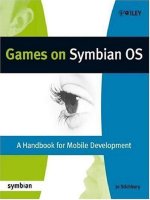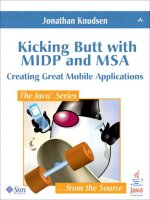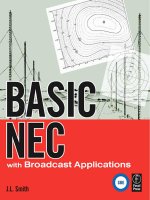Focal press basic NEC with broadcast applications apr 2008 ISBN 0240810732 pdf
Bạn đang xem bản rút gọn của tài liệu. Xem và tải ngay bản đầy đủ của tài liệu tại đây (3.29 MB, 300 trang )
Basic NEC
with Broadcast
Applications
THE PURPOSE OF COMPUTING IS INSIGHT,
NOT NUMBERS
– R.W. Hamming
Basic NEC
with Broadcast
Applications
J.L. Smith, PE
AMSTERDAM • BOSTON • HEIDELBERG • LONDON NEW YORK • OXFORD
PARIS • SAN DIEGO • SAN FRANCISCO • SINGAPORE • SYDNEY • TOKYO
Focal Press is an imprint of Elsevier
Acquisitions Editor: Angelina Ward
Publishing Services Manager: George Morrison
Project Manager: Marilyn E Rash
Assistant Editor: Kathryn Spencer
Marketing Manager: Christine Degon Veroulis
Design Direction: Joanne Blank
Cover Design: Gary Ragaglia
Cover Images © J.L. Smith
Text Printer: Sheridan Books
Cover Printer: Phoenix Color Corp.
Focal Press is an imprint of Elsevier
30 Corporate Drive, Suite 400, Burlington, MA 01803, USA
Linacre House, Jordan Hill, Oxford OX2 8DP, UK
Copyright © 2008, Elsevier Inc. All rights reserved.
No part of this publication may be reproduced, stored in a retrieval system, or transmitted
in any form or by any means, electronic, mechanical, photocopying, recording, or otherwise,
without the prior written permission of the publisher.
Permissions may be sought directly from Elsevier’s Science & Technology Rights Department
in Oxford, UK: phone: (ϩ44) 1865 843830, fax: (ϩ44) 1865 853333, E-mail:
You may also complete your request on-line via the Elsevier homepage (), by
selecting “Support & Contact” then “Copyright and Permission” and then “Obtaining Permissions.”
Library of Congress Cataloging-in-Publication Data
Smith, J.L.
Basic NEC with broadcast applications / J.L. Smith.
p. cm.
Includes index.
ISBN 978-0-240-81073-7 (alk. paper)
1. Antenna arrays. 2. Radio—Transmitters and transmission. 3. Transmitters and transmission.
I. Title.
TK7871.6.S566 2008
621.384’135—dc22
2008004493
British Library Cataloguing-in-Publication Data
A catalogue record for this book is available from the British Library.
For information on all Focal Press publications
visit our website at www.books.elsevier.com
08 09 10 11 12
54321
Printed in the United States of America
To my lovely wife, Marguerite,
who has been in my corner for 63 years.
She assures me that I’m the Champ,
she tells me that I’m winning,
and she pushes me back into the ring
to fight another round.
This page intentionally left blank
Contents
Foreword
Preface
Acknowledgments
About the Author
CHAPTER 1
1.1
1.2
1.3
1.4
1.5
1.6
1.7
xiii
xv
xix
xxi
The Array Adjustment Process .....................................................1
The Nature of NEC-2 ..................................................................................1
The Directional Antenna Adjusting Process ...............................................1
Local and Global Minima ...........................................................................2
The Role of NEC-2 .....................................................................................4
Analysis Overview......................................................................................5
Additional NEC-2 Benefits ..........................................................................6
Software Requirements ..............................................................................7
CHAPTER 2 NEC-2 Fundamentals ........................................................................9
2.1
2.2
2.3
2.4
Scope ........................................................................................................9
The NEC-2 Engine ......................................................................................9
NEC-2 Operation ......................................................................................11
Creating the Input File .............................................................................11
2.4.1 Naming the Files ...........................................................................11
2.4.2 Data Commands ............................................................................12
2.4.3 Data Command Types ...................................................................13
2.4.4 An Input File Illustration ...............................................................13
2.5 Reading the Output File ...........................................................................17
2.5.1 The Header ...................................................................................18
2.5.2 Structure Specifications ................................................................18
2.5.3 Segmentation Data ........................................................................18
2.5.4 Data Commands, Frequency, Loading, and
Environment Data .........................................................................21
2.5.5 Antenna Input Parameters ............................................................22
2.5.6 Currents and Locations .................................................................22
2.5.7 Current Moments ..........................................................................23
2.5.8 Power Budget ................................................................................24
2.5.9 Radiation Pattern...........................................................................24
2.6 Exercises ..................................................................................................26
CHAPTER 3 Modeling the Radiator ...................................................................27
3.1 Modeling Guidelines ...............................................................................27
3.2 Guideline Summary .................................................................................29
vii
viii
Contents
3.2.1 Modeling the Radiator...................................................................29
3.2.2 Modeling the Voltage Source.........................................................29
3.3 Tower Configurations ..............................................................................30
3.3.1 Single-Wire Configuration .............................................................31
3.3.2 Four-Wire Configuration ...............................................................31
3.3.3 Two-Wire Configuration................................................................32
3.3.4 Lattice Configuration ....................................................................32
3.4 Viewing Tower Configuration ..................................................................38
3.5 Exercises ..................................................................................................39
CHAPTER 4 Array Geometry .................................................................................41
4.1
4.2
4.3
4.4
The Coordinate System ............................................................................41
Array Geometry: An Example ..................................................................44
The Array Input File .................................................................................46
Exercises ..................................................................................................50
CHAPTER 5 Loads, Networks, and Transmission Lines ............................51
5.1 Modeling Impedance Loads .....................................................................51
5.2 Modeling Nonradiating Networks............................................................53
5.2.1 Typical Networks ..........................................................................54
5.2.2 Typical Network Applications .......................................................55
5.2.3 General Guidelines for Networks .................................................57
5.3 Modeling Transmission Lines ...................................................................57
5.4 Network Output File Listing ....................................................................59
5.4.1 Network Descriptions...................................................................59
5.4.2 Source and Load Impedance to the Networks ..............................60
5.4.3 Network Input Parameters............................................................61
5.5 Exercises ..................................................................................................61
CHAPTER 6 Calculating Base Drive Voltages ...............................................63
6.1
6.2
6.3
6.4
Base Drive Voltages ..................................................................................63
Direct and Induced Currents ...................................................................63
Current Moments .....................................................................................66
Development Concept.............................................................................67
6.4.1 Unity Drive ....................................................................................68
6.4.2 Normalized Drive ..........................................................................69
6.4.3 Full Power Drive ...........................................................................71
6.4.4 Shunt Reactance and Networks ....................................................71
6.5 Example: A Three-Tower Array .................................................................72
6.5.1 Create a Unity Drive File ...............................................................72
6.5.2 Calculate Unity Drive Current Moments.......................................73
Contents
6.5.3 Solve for the Normalized Drive Voltages .......................................77
6.5.4 Determine the Full Power Drive Voltages .....................................78
6.6 Exercises ..................................................................................................79
CHAPTER 7 Using Data from the Output File .................................................81
7.1
7.2
7.3
7.4
Overview .................................................................................................81
Verify the Field Ratios ..............................................................................82
Plot Far-Field Radiation Pattern ................................................................83
Detuning Unused Towers .........................................................................84
7.4.1 Detuning by Base Loading ............................................................85
7.4.2 Detuning by Skirting .....................................................................89
7.5 Antenna Monitor Readings ......................................................................94
7.5.1 Optimum Height for Sample Loops ..............................................95
7.5.2 Arbitrary Height for Sample Loops ...............................................96
7.5.3 Base Current Samples ...................................................................97
7.5.4 Base Voltage Samples.....................................................................99
7.6 Drive Point Impedance ..........................................................................100
7.6.1 Drive Point Impedance When Using a Network .........................100
7.7 Exercises ................................................................................................102
CHAPTER 8 Model by Measurement...............................................................105
8.1 Objective................................................................................................105
8.2 Adjusting the Model ...............................................................................107
8.2.1 Number of Segments ..................................................................108
8.2.2 Tower Diameter ..........................................................................111
8.2.3 Segment and Radius Taper ..........................................................114
8.2.4 Base Capacity ..............................................................................116
8.2.5 Drive Segment Radius .................................................................118
8.3 Exercise..................................................................................................120
CHAPTER 9 Top-Loaded and Skirted Towers ..............................................121
9.1 General Considerations..........................................................................121
9.2 Top Loading ...........................................................................................122
9.2.1 Estimating the Size of the Top Hat ..............................................122
9.2.2 Determining the Degree of Top Loading.....................................123
9.3 Skirted Towers .......................................................................................126
9.4 Folded Monopole ...................................................................................129
9.5 Exercises ................................................................................................132
ix
x
Contents
CHAPTER 10
System Bandwidth Analysis....................................................133
10.1 Introduction ........................................................................................133
10.2 System Definition ................................................................................133
10.2.1 Tower Models........................................................................134
10.2.2 Tower Base Drive Voltages ....................................................136
10.3 Bandwidth Analysis .............................................................................137
10.3.1 Source Impedance of the Drive Voltage ................................137
10.3.2 Intermediate Data .................................................................140
10.3.3 Total System Bandwidth Data ...............................................146
10.4 Bandwidth Conclusions ......................................................................148
CHAPTER 11
Case Studies .................................................................................149
11.1 Comparative Data ...............................................................................149
11.2 Case Study 1: Three-Tower Array ........................................................149
11.2.1 Array Description: Three-Tower Array ..................................149
11.2.2 Self-Impedance: Three-Tower Array ......................................149
11.2.3 Antenna Monitor Reading: Three-Tower Array .....................151
11.2.4 Array Data: Three-Tower Array ..............................................152
11.2.5 Discussion: Three-Tower Array .............................................153
11.2.6 NEC-2 Input File: Three-Tower Array ....................................153
11.3 Case Study 2: Six-Tower Array, Day Pattern .........................................154
11.3.1 Array Description: Six-Tower Array, Day Pattern....................154
11.3.2 Self-impedance: Six-Tower Array, Day Pattern ........................154
11.3.3 Antenna Monitor Reading: Six-Tower Array,
Day Pattern ............................................................................155
11.3.4 Array Data: Six-Tower Array, Day Pattern ...............................156
11.3.5 Discussion: Six-Tower Array, Day Pattern ...............................157
11.3.6 NEC-2 Input File ....................................................................158
11.4 Case Study 3: Six-Tower Array, Night Pattern .......................................160
11.4.1 Array Description: Six-Tower Array, Night Pattern .................160
11.4.2 Self-Impedance: Six-Tower Array, Night Pattern.....................160
11.4.3 Antenna Monitor Readings: Six-Tower Array,
Night Pattern .........................................................................160
11.4.4 Array Data: Six-Tower Array, Night Pattern ............................161
11.4.5 Discussion: Six-Tower Array, Night Pattern ............................161
11.4.6 NEC-2 Input File: Six-Tower Array, Night Pattern ...................165
11.5 Case Study 4: Tall-Tower Array ............................................................166
11.5.1 Array Description: Tall Towers ..............................................166
11.5.2 Self-Impedance: Tall Towers ..................................................166
11.5.3 Antenna Monitor Reading: Tall Towers .................................167
11.5.4 Array Data: Tall Towers..........................................................167
Contents
11.5.5 Discussion: Tall Towers .........................................................169
11.5.6 NEC-2 Input File: Tall Towers ................................................169
CHAPTER 12
Supplemental Topics .................................................................171
12.1
12.2
12.3
12.4
12.5
Introduction ........................................................................................171
Parallel Feeds: Network Combiners ....................................................171
New Structures: The NX Command ...................................................173
Numerical Green’s Function ...............................................................175
Ground Screens...................................................................................177
12.5.1 The GN Command ................................................................177
12.5.2 The GR Command.................................................................178
12.6 Finite Ground ......................................................................................181
12.6.1 Reflection Coefficient Approximation ..................................182
12.6.2 Sommerfeld/Norton Analysis.................................................182
APPENDIX A
NEC-2 Input File Statements ..................................................185
1.0 Comment Commands (CM, CE) ..........................................................187
2.0 Structure Geometry Commands .........................................................189
3.0 Program Control Commands ..............................................................211
APPENDIX B
Error Messages ............................................................................251
APPENDIX C
Software ..........................................................................................259
Introduction ........................................................................................259
Disk Content .......................................................................................259
Essential Software ...............................................................................260
Software Installation ...........................................................................260
User Manual ........................................................................................262
3.1.1 bnec.exe .................................................................................262
NVCOMP.EXE ......................................................................................263
NecDrv2.EXE ......................................................................................265
NECMOM.EXE.....................................................................................266
WJGRAPS.EXE .....................................................................................266
Software Support ................................................................................267
1.1
1.2
1.3
2.1
3.1
3.2
3.3
3.4
3.5
4.1
Index............................................................................................... 269
xi
This page intentionally left blank
Foreword
The development of computer programs for modeling antennas began
in the 1960s when main-frame computers were making advancements.
Modeling codes that could run on desktop computers made their
appearance in the early 1980s. The design of directional antenna arrays
for medium-frequency (MF) broadcasting stations has a much longer
history, however, reaching back to the mid-1930s when computations
were done using a slide rule.
In the early years, methods involving approximations (such as the
assumption of sinusoidal current distributions on the radiators) were
developed and broadcasters have used them with reasonable success
up to the present day. For the most part, however, to do that work the
broadcaster’s use of the computer has been relegated primarily to
arithmetical operations rather than to actual modeling of the antenna.
The success of simple design methods, and the fact that the generalpurpose modeling codes and broadcast antenna engineers sometimes
seem to “speak a different language,” may account for the somewhat
slow adoption of computer modeling by the broadcast community.
J.L. Smith has extensive experience in directional antenna design,
which began long before the development of computer modeling. In
Basic NEC with Broadcast Applications, he describes methods he has
developed to use the public domain NEC-2 modeling code to design
and tune MF directional antenna arrays. Some of the methods parallel
the techniques developed by the navy’s antenna designers by starting
with simplified models and sometimes adjusting the models to match
measurements. By using these methods, model parameters can be varied or features can be added to study effects.
In teaching courses on antenna modeling, we have found that new
users often start by trying to model with too much detail. As a result,
they run into problems with code limitations and eventually produce
a large model that takes a long time to run and makes it difficult to try
variations. Smith shows how to start with simple models, how to allow
for code limitations and still get the important information. He illustrates
xiii
xiv
Foreword
the effectiveness of his methods by eventually comparing model results
to measurements.
This book should be useful for both the beginning student and the
working broadcast engineer. Beyond learning the methods described,
you will be encouraged to see that it is possible for an ordinary user to
get valuable results from the free public domain NEC-2 computer code.
Jerry Burke
Livermore, California
Preface
The Numerical Electromagnetics Code version 2 (NEC-2) is a public
domain computer program that eliminates most of the shortcomings
inherent in the conventional design methods for medium-frequency
(MF) broadcast directional antennas. It is most useful for the increasingly complex arrays, and it yields parameter settings that greatly aid
the initial adjustment of a new array.
NEC-2 was developed at Lawrence Livermore National Laboratories
by G. J. Burke and A. J. Poggio in 1981 as a general-purpose tool for the
design and analysis of antennas in general. For the most part, its published applications deal only with antennas that have a single drive
source such as those found on dipoles, yagis, rhombics, and so on.
Broadcast applications, on the other hand, use multiple sources to individually drive the separate elements of a multi-element array, with each
source having a unique magnitude and phase so as to create a particular radiation pattern.
NEC-2 is not necessarily user-friendly to the broadcaster. From the
very beginning, it gives the broadcaster a swift kick in the shin when it
calls for defined source voltages as the inputs to initiate a given antenna
analysis, whereas broadcasters have conventionally started their design
with a given set of field ratios. Then among other complications, NEC-2
uses the coordinate system common to mathematics, whereas broadcasters have traditionally used the geographical coordinate system.
Then NEC-2 deals with peak values, not RMS, as does the broadcaster.
Thus, while NEC-2 is indeed a magnificent tool, it is not at all
directed to broadcast use. As a result, when NEC-2 first made its appearance, it was not immediately accepted by the broadcast community
and only a few broadcast engineers even attempted to use it.
In time, however, broadcast engineers with various levels of expertise studied the use of NEC-2 and each developed their own postprocessing software to read data from the standard output file and to
use that data to perform the various tasks necessary for broadcast work.
Such studies have been carried on rather independently, and somewhat privately, however, and some engineers even consider their work
xv
xvi
Preface
proprietary. Unfortunately, little of the work has been published to
enjoy peer review or to serve as tutorials for those seeking entry into
the profession.
In recent years, some engineers have written software to make the
moment method programs more user-friendly to the broadcaster, and
some of the more developed efforts have been packaged as commercial products for sale to the broadcast community. The consensus is,
however, that the commercial products all use the same basic moment
method engine and that they differ mainly in the user interface with,
perhaps, some special features added.
Because there has been such a diversity in the development of the
procedures for applying NEC-2 calculations to broadcast arrays, there
may be multiple approaches to accomplish a given analysis, and each
approach possesses merit. Therefore, as you study NEC-2 from this book
and other sources, you might find additional and even contradicting
methods of analysis; in that case, I encourage you to weigh the merits
of each and to exercise your judgment as to the best use of available
methods.
At the present time, there is no modern and comprehensive tutorial available to a person desiring to enter the field of MF directional
antenna design, and the few remaining people who are knowledgeable of the science are becoming older and, unfortunately, fewer. This
regrettable circumstance occurs at a time when we are on the brink of
a resurgence of need as new forms of modulation make their way into
the MF band. Digital modulation methods make it necessary to renew
our interest in directional antenna systems as we study bandwidth
requirements and learn new implementation schemes to accommodate
the more sophisticated application. At the same time, 5000 existing
directional antenna systems continue to demand maintenance, and the
need for replacement grows as they come to their life’s end at the rate
of approximately 100 per year.
Basic NEC with Broadcast Applications was written to show how
the features of NEC-2 can be accommodated in the design and analysis of MF broadcast directional antennas. I also envision this book as a
depository where one may come to learn modern basics of the science;
in so doing, the book will assist younger people who wish to enter the
field. This book also serves as a useful desk reference that can remind
Preface
the professional user of the many details encountered while using
NEC-2 to analyze and design modern MF directional antenna arrays.
Finally, a somewhat lofty goal is that others more skilled in the
science than I will see this book as an incentive to make their own
contributions to publicly documenting the use of NEC for broadcast
applications.
xvii
This page intentionally left blank
Acknowledgments
Someone once said, “We see the future by standing upon the shoulders
of those who have gone before us.” While I don’t mean to imply that
the following persons have preceded me in time (for I’m much too
old for that), I do want to acknowledge that they have preceded me in
knowledge and that they have given of that knowledge generously to
make this book possible.
My sincere appreciation goes to the many people who have contributed to this book, but I am especially indebted to:
■
Gerald J. (Jerry) Burke, of Lawrence Livermore National Laboratory
and cocreator of NEC-2, who gave so generously of his time to
review this manuscript and to make many valuable suggestions.
■
Jack Sellmeyer, Sellmeyer Engineering, McKinney, TX, and former
coworker at Collins Radio Company, whose contributions and
patience through the years have provided the practical experience necessary to bring realism to theory.
■
Paul Carlier, FanField, Ltd., UK, for his contribution to, and review
of, that portion of the manuscript pertaining to measured data.
And for years of discussions and the sharing of practical experience,
I express my sincere appreciation to my long-time friend, Paul Cram,
Broadcast Technical Services, Mansfield, GA, who started working with
directional antennas when the concept first appeared in 1935. Now
in his nineties, Paul is still in the profession and aggressively applying
NEC-2 to broadcast directional antennas.
xix
This page intentionally left blank
About the Author
J.L. Smith received a B.S. degree in physics from the University of
Houston in 1956 and an M.S. degree in engineering from Southern
Methodist University in 1959. He began his career in broadcasting at
KTRH in Houston in 1946. In 1956, he joined Collins Radio Company
where he held the usual positions in research and development culminating in head of the Department of Research and Development.
He served as the manager of Broadcast Systems Engineering at Collins
Radio Company during the 1960s. While there he directed the development of a complete catalog of new broadcast products.
Mr. Smith has been active in FCC matters, having filed the first
petition advocating automatic unattended operation of FM broadcast transmitters. He participated in the coordination of international
broadcasting through his service on CCIR Study Group 10 and has
participated in various national and international symposia. J.L. Smith
has authored approximately 50 technical papers and has published
two other books—Basic Mathematics with Electronics Applications
(Macmillan, 1972) and Intermodulation Prediction and Control
(Interference Control Technologies, 1993).
He is now retired in Covington, Louisiana, where he devotes much
of his time to analytical research pertaining to AM directional antennas.
xxi
This page intentionally left blank
CHAPTER
The Array Adjustment
Process
1
1.1 The Nature of NEC-2
It is important to recognize that the Numerical Electromagnetics Code
(NEC) is no magic tool—it does some things very well but it cannot do
other things. In spite of this, it is a valuable tool that makes a significant
contribution to easing the design and adjustment of medium-frequency
(MF) broadcast directional antennas.
The user of NEC-2 should have realistic expectations, and recognize from the outset, that the results of a NEC-2 analysis are, at best, an
approximation, and they are not necessarily exact answers. Fortunately,
however, the results of a NEC-2 analysis need not be precise to be
beneficial.
1.2 The Directional Antenna Adjusting Process
The process of physically adjusting the network components of an
array to achieve a desired pattern is very similar to that of mathematically synthesizing a radiation pattern using computerized optimizing methods. Both processes start with a given pattern, compare it to
a target, determine an error, and then make parameter adjustments in
an attempt to reduce the error. In the physical adjustment process, the
pattern error is a matter of human opinion; in the case of computerized
pattern synthesis, the error is defined mathematically.
1
2
CHAPTER 1 The Array Adjustment Process
The mathematical synthesis process and the physical adjustment
process possess the same significant limitation in that neither can
know when the minimum error has actually been reached. Therefore,
in both cases the usual practice is to test a potential error minimum
by changing a parameter value and noting the effect on the error. If
the error increases, then the parameter is returned to its original value
and another parameter value is changed. If all the parameter values are
changed in turn and none reduces the error, then it is often assumed
that the error is at a minimum.
The task does not end there, however. The error may indeed be at
a minimum, but it may not be at the absolute minimum. There may be
another set of parameters that will create an even smaller error. That
concept can be better understood by considering the following analogy.
1.3 Local and Global Minima
The pattern error can be envisioned as an N ϩ 1 dimension surface
where N is the number of variables.
Figure 1-1 shows a three-dimensional error surface of two variables,
arbitrarily called Field Ratio and Phase for example purposes. Point
S in Figure 1-1 is taken as an arbitrary starting point from which we
Error
S
M
Phase
M'
S'
Field
ratio
FIGURE 1-1
Error surface of two variables.









